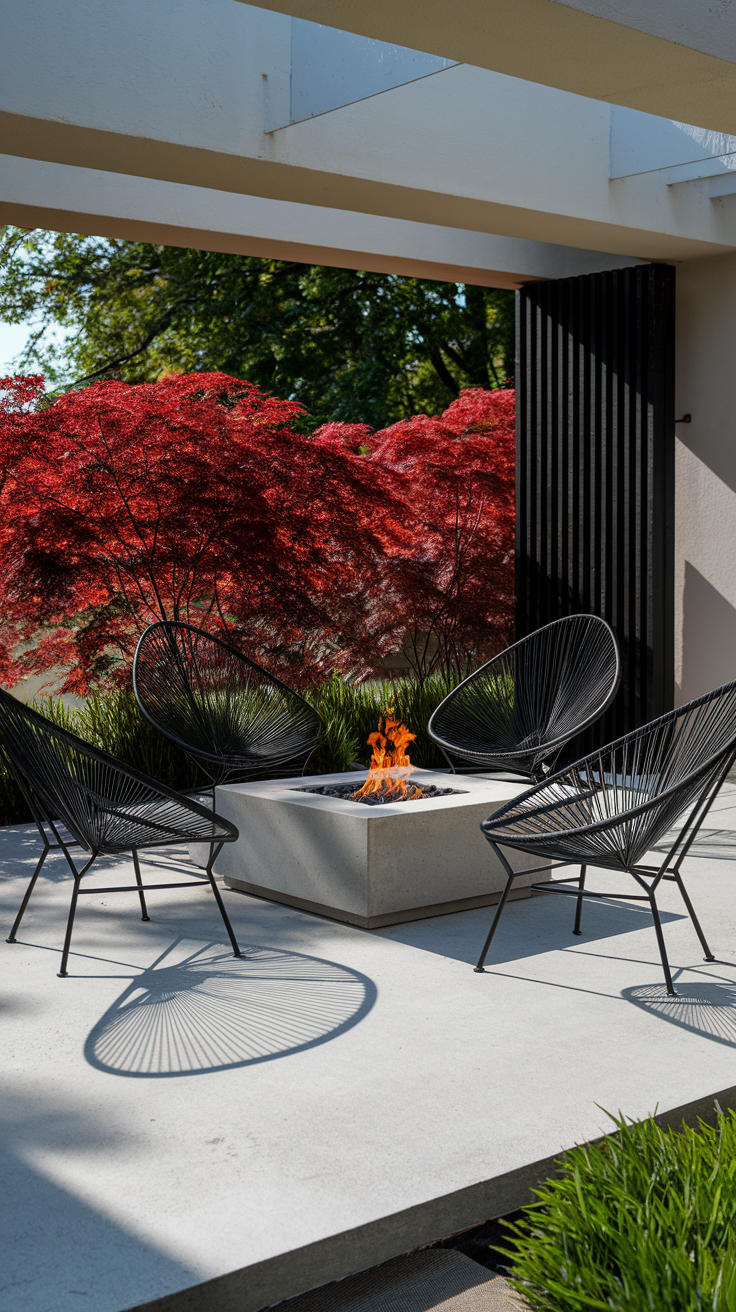Fire Pit Under a Tree: Is It Safe?
Fire Pit Under a Tree: Is It Safe?

If you’re looking to add some warmth and ambiance to your backyard, a fire pit is a great option. But what if you have a tree in your backyard? Can you place a fire pit under a tree? The answer is yes, but you need to take some precautions to ensure safety.
When selecting the right location for your fire pit, make sure the tree is far enough away from the fire pit. This prevents the heat, sparks, and smoke from damaging the tree or starting a fire. You should also choose a location that is level and away from any structures or flammable materials. Understanding fire pit safety is essential to prevent accidents and injuries.
When choosing materials and fuel for your fire pit, there are several options to consider. Brick and stone are popular choices for fire pit construction, while propane and natural gas are convenient fuel options. No matter what materials and fuel you choose, make sure to follow installation and maintenance guidelines to ensure your fire pit is safe and in good working condition.
Key Takeaways
- Select a location for your fire pit that is far enough away from trees, structures, and flammable materials.
- Choose materials and fuel that are safe and follow installation and maintenance guidelines.
- Understanding fire pit safety is essential to prevent accidents and injuries.
Selecting the Right Location
When it comes to placing a fire pit under a tree, selecting the right location is crucial. Here are some important factors to consider:
Distance from Trees and Structures
The first thing you need to do is to determine the safe distance between the fire pit and any trees or structures in the area. According to Backyard Toasty, the fire pit should be placed no less than 10 feet away from any structure, and 20-25 feet or more is best. Additionally, make sure that the fire pit is far enough away from any trees with low-hanging limbs, woodpiles, bushes, and other materials that could ignite if contact with a flame is made.
Assessing Overhead Hazards
It’s important to assess any overhead hazards in the area where you plan to place the fire pit. This includes any low-hanging branches or other structures that could potentially catch fire. Make sure that there is enough clearance above the fire pit to prevent any accidents from happening.
Evaluating Ground Conditions
The ground where you plan to place the fire pit should be level and solid. Avoid placing the fire pit on a slope or uneven surface. Additionally, make sure that the area is clear of any flammable materials such as dry leaves, grass, or other debris.
It’s also a good idea to check with your local fire department to see if there are any regulations or guidelines that you need to follow when it comes to fire pit placement on your property.
Understanding Fire Pit Safety
If you are planning to have a fire pit under a tree, it is important to follow safety precautions to prevent any potential hazards. Here are some tips to help you stay safe:
Preventing Fire Spread
One of the most important safety rules when having a fire pit under a tree is to keep it at least 10-15 feet away from any trees or other flammable materials. This will help prevent any potential fire spread. Also, make sure to remove any dry debris or combustible materials from the area around the fire pit.
Emergency Preparedness
It is always important to be prepared for any emergency situations. Keep a bucket of water or a fire extinguisher nearby in case of any unexpected fire. Also, make sure to have a hose within reach to put out any sparks or embers that may fly out of the fire pit.
Supervision and Compliance
It is important to supervise the fire pit at all times to prevent any accidents. Make sure to follow any local regulations regarding fire safety and fire protection. Additionally, consider using a fire-resistant mat or a fireproof barrier underneath the fire pit to prevent any damage to the ground.
Choosing Materials and Fuel
When selecting materials for your fire pit, make sure to choose non-flammable materials. This includes materials for the pit itself, as well as the surrounding area. Some common non-flammable materials include metal, sand, and stones. These materials can help prevent the fire from spreading to nearby flammable materials such as leaves and grass.
Selecting Non-Flammable Materials
For the fire pit itself, metal is a popular choice due to its durability and heat resistance. However, make sure that the metal is thick enough to withstand the heat of the fire. Stones and bricks are also good options for the pit, as they are non-flammable and can withstand high temperatures.
When selecting a location for your fire pit, make sure to choose an area that is clear of any flammable materials such as roots and dry leaves. If you are placing your fire pit under a tree, ensure that there are no low-hanging branches that could catch fire.
Fuel Types and Storage
There are several fuel types to choose from when using a fire pit. Logs and firewood are popular choices, but you need to ensure that they are dry before use. Pine is a common type of firewood, but it can produce more creosote and smoke than other types of wood.
Propane is another popular fuel option for fire pits. It is easy to use and produces less smoke than wood. However, make sure to store propane tanks in a cool, dry place away from any heat sources.
It is important to properly dispose of ashes and other debris after using your fire pit. Store any unused firewood or logs in a dry area away from the fire pit to prevent them from becoming a fire hazard. Avoid using lighter fluid, gasoline, or other flammable liquids to start your fire, as they can be dangerous and produce harmful fumes.
Installation and Maintenance
Proper Installation Techniques
When installing a fire pit under a tree, there are several factors to consider to ensure safety and compliance with local regulations.
First, choose a suitable location that is at least 10-15 feet away from any trees, shrubs, or vegetation to prevent heat damage and wildfires. Make sure the area is clear of any debris, dirt, or low-hanging branches that could catch fire.
It is also important to select the right materials for your fire pit. Bricks, pavers, or an enclosed area are ideal for building a fire pit under a tree. Avoid using flammable materials or elevated structures that could pose a fire hazard.
Before starting the installation process, check with your local fire department to see if you need a permit or if there are any regulations you need to comply with. Additionally, consider weather conditions and avoid installing the fire pit on windy days.
Regular Maintenance and Upkeep
Proper maintenance and upkeep of your fire pit under a tree are crucial to ensure safety and prevent fines.
Regularly prune any low-hanging branches that could catch fire and keep the surrounding area clear of debris. You should also have a garden hose or other source of water nearby in case of an emergency. Also, never leave the fire pit unattended, especially if you have pets or children around.
It is also important to avoid using alcohol or other flammable substances near the fire pit. Carbon monoxide is a dangerous gas that can build up when burning wood, so make sure the area is well-ventilated and never use the fire pit in an enclosed area such as a garage or under a roof line.
Frequently Asked Questions
Is it safe to use a smokeless fire pit near trees?
Yes, it is safe to use a smokeless fire pit near trees as long as you follow safety guidelines. Smokeless fire pits are designed to produce less smoke than traditional fire pits, which reduces the risk of damaging nearby trees. However, you still need to keep the fire pit a safe distance from the tree and use fire-resistant materials for the base.
What are creative fire pit ideas that ensure safety around trees?
Some creative fire pit ideas that ensure safety around trees include using a raised fire pit, installing a fire pit on a concrete or stone patio, or building a fire pit with a fire ring. These options help to keep the fire contained and reduce the risk of spreading to nearby trees.
How far should a wood-burning fire pit be placed from a tree?
A wood-burning fire pit should be placed at least 10-15 feet away from a tree to prevent accidental fires and heat damage to foliage. The distance may vary depending on the size of the fire pit, the type of tree, and the local regulations.
What precautions should be taken when installing a propane fire pit under tree branches?
When installing a propane fire pit under tree branches, make sure the branches are at least 10 feet away from the fire pit. This will reduce the risk of the branches catching fire and spreading the fire to the tree. Additionally, you need to use fire-resistant materials for the base and keep a fire extinguisher and garden hose nearby.
What materials are recommended for the base of a fire pit to prevent ground damage?
Fire pits should be placed on a fire-resistant surface such as concrete, pavers, or gravel to prevent ground damage. You should avoid placing the fire pit directly on grass or other flammable materials as this can increase the risk of accidental fires.
What guidelines should be followed for overhead tree limb clearance above a fire pit?
Overhead tree limb clearance above a fire pit should be at least 10 feet to prevent the tree from catching fire.
Regularly trim tree branches and remove any dead or dry branches that may pose a fire hazard.
Additionally, check local regulations for any additional guidelines or restrictions.






